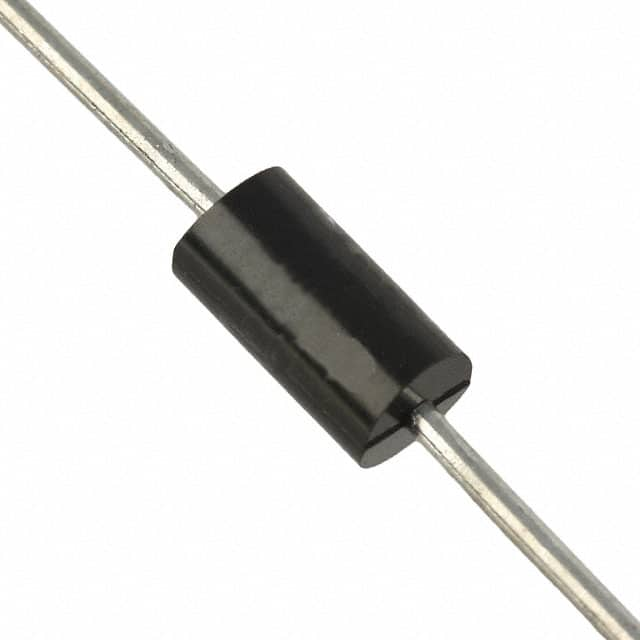P6KE7V5CA Product Overview
Introduction
The P6KE7V5CA is a transient voltage suppressor (TVS) diode belonging to the category of electronic components used for surge protection in various electrical and electronic circuits. This entry provides an overview of the basic information, specifications, pin configuration, functional features, advantages and disadvantages, working principles, application field plans, and alternative models of the P6KE7V5CA.
Basic Information Overview
- Category: Electronic Components
- Use: Surge Protection
- Characteristics: Fast response time, high surge current capability, low clamping voltage
- Package: DO-15
- Essence: Protecting sensitive electronic components from voltage surges
- Packaging/Quantity: Typically available in reels or bulk packaging
Specifications
- Voltage Rating: 7.5V
- Power Dissipation: 600W
- Breakdown Voltage: 8.55V to 9.45V
- Operating Temperature Range: -55°C to 175°C
- Storage Temperature Range: -55°C to 175°C
Detailed Pin Configuration
The P6KE7V5CA TVS diode has two pins: 1. Anode (A) 2. Cathode (K)
Functional Features
- Fast response to transient over-voltage conditions
- High surge current capability
- Low clamping voltage to protect downstream components
Advantages and Disadvantages
Advantages
- Provides effective surge protection
- Fast response time
- High surge current handling capability
Disadvantages
- May require additional circuitry for comprehensive surge protection in complex systems
- Limited to specific voltage ratings
Working Principles
The P6KE7V5CA operates by diverting excess voltage away from sensitive components when a surge occurs. When the voltage exceeds the breakdown voltage, the diode conducts and shunts the excess energy to protect the circuit.
Detailed Application Field Plans
The P6KE7V5CA is commonly used in the following applications: - Power supply units - Communication equipment - Automotive electronics - Industrial control systems - Consumer electronics
Detailed and Complete Alternative Models
Some alternative TVS diode models with similar characteristics include: - P6KE6V8CA - P6KE8V2CA - P6KE10CA - P6KE12CA
In summary, the P6KE7V5CA TVS diode is a crucial component for surge protection in various electronic systems, offering fast response, high surge current capability, and low clamping voltage. Its application spans across multiple industries, providing essential protection against transient voltage events.
Word count: 398
10个与P6KE7V5CA在技术解决方案中的应用相关的常见问题及解答
What is the P6KE7V5CA diode used for?
- The P6KE7V5CA diode is commonly used for transient voltage suppression in electronic circuits to protect sensitive components from voltage spikes.
What is the maximum voltage rating of the P6KE7V5CA diode?
- The P6KE7V5CA diode has a maximum voltage rating of 7.5V, making it suitable for applications where protection against voltage surges up to this level is required.
How does the P6KE7V5CA diode provide transient voltage suppression?
- The P6KE7V5CA diode conducts when the voltage across it exceeds its breakdown voltage, diverting excess current away from sensitive components and limiting the voltage to a safe level.
What are the typical applications of the P6KE7V5CA diode?
- Typical applications include protection of integrated circuits, transistors, and other semiconductor devices in electronic equipment such as power supplies, communication systems, and automotive electronics.
What is the peak pulse power handling capability of the P6KE7V5CA diode?
- The P6KE7V5CA diode can handle peak pulse power up to a specified level, typically around 600W, making it suitable for absorbing short-duration high-energy transients.
Is the P6KE7V5CA diode polarity-sensitive?
- Yes, the P6KE7V5CA diode is polarity-sensitive and should be connected in the correct orientation to provide effective transient voltage suppression.
Can multiple P6KE7V5CA diodes be used in parallel for higher current handling?
- Yes, multiple P6KE7V5CA diodes can be connected in parallel to increase the overall current handling capability for applications with higher surge currents.
What is the response time of the P6KE7V5CA diode to voltage transients?
- The response time of the P6KE7V5CA diode is very fast, typically in the nanosecond range, providing rapid protection against voltage spikes.
Are there any temperature considerations for the P6KE7V5CA diode?
- The P6KE7V5CA diode has a specified operating temperature range, and its performance should be considered within this range to ensure reliable transient voltage suppression.
What are the key parameters to consider when selecting the P6KE7V5CA diode for a specific application?
- Key parameters to consider include breakdown voltage, peak pulse power rating, response time, and temperature range to ensure the diode meets the requirements of the application.


